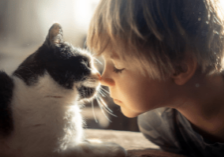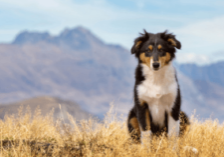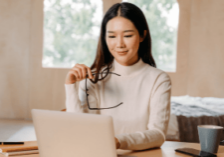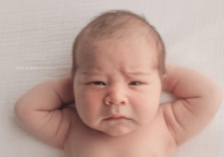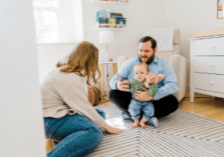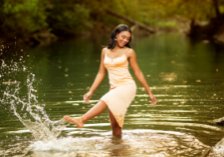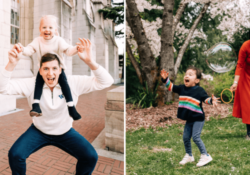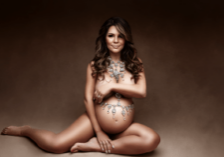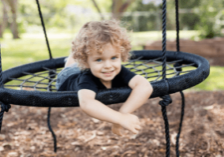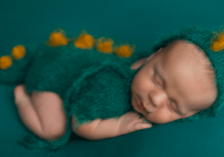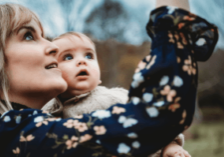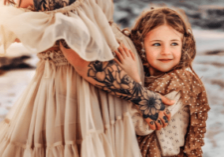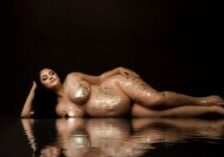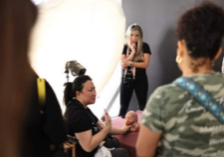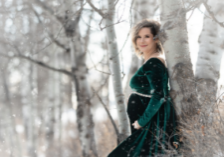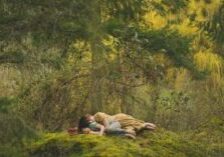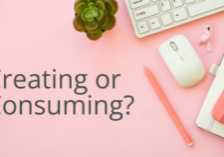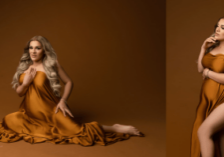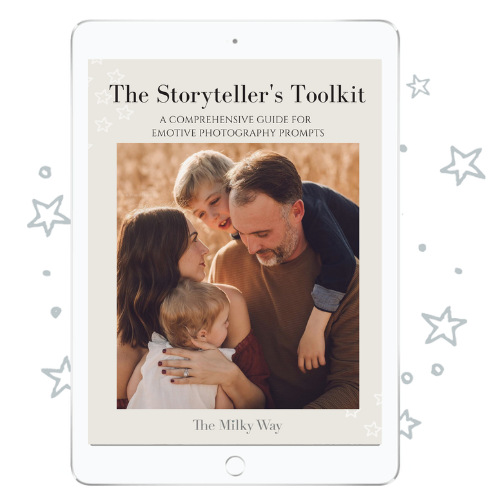The Art of Connection: Infusing Emotion and Body Language in Photography with Denise Birdsong
As photographers, I bet many of us have experienced flat, uninteresting photos when we haven’t felt a connection with our clients, especially when we started out. That emotional connection is the magic sauce that makes your photos shine.
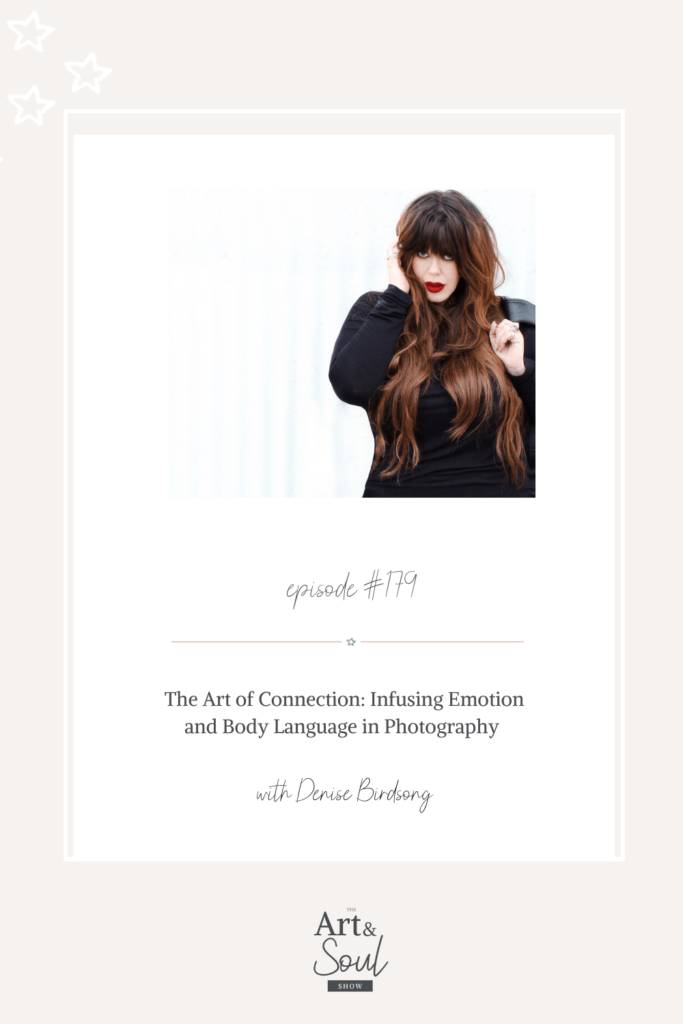
In order to foster that connection, we have to build trust and we have to be willing to steer the emotional ship, if you will. Don’t be afraid to let your own emotions out in order to inspire your clients to do the same.
In today’s episode, I’m interviewing Denise Birdsong, an award-winning wedding portrait and boudoir photographer from the San Francisco Bay Area, who is a pioneer of emotive photography. Denise shares her advice for how to infuse your photos with real emotion, how to build trust and connection with your clients, and how photography itself is changing because of a greater emphasis on emotions.
What’s in this episode:
- [02:48] What Denise is passionate about in photography and how her grandmother helped her find her voice as an artist
- [11:08] The challenges Denise has faced as an artist, namely, being called an artist in the first place
- [17:03] Denise is the master of infusing emotion into her work and she gives some advice for anyone who is drawn to it but might be scared to start
- [24:00] Why trust is so incredibly important when it comes to creating connections with your clients
- [28:51] Why there’s a renaissance of emotion in photos currently and how photography is evolving because of it
- [31:34] The legacy that Denise’s mom has left on her creative work
Tune in to this episode for how to infuse emotion and connection into your next photo session.
SUBSCRIBE: Apple Podcasts | Spotify | Stitcher
Want to put an end to awkward moments in your photo sessions and create genuine connection? Download The Storyteller’s Toolkit today, featuring 200+ emotive photography prompts, so you’re never left wondering what to say.
Meet Denise
Denise Birdsong is an award-winning wedding portrait and boudoir photographer from the San Francisco Bay Area. Through her experience as a dancer and model, she’s mastered the fine art of communication and storytelling through body language and facial expression. Emotion is what makes portrait photography truly stand out, and it’s usually the missing component for most photographers. She’s passionate about mentoring her photography students with her signature methodology, The Art of Emotion: Stripped Down that takes them to the next level of their craft.
Connect with Denise
Subscribe to Denise’s YouTube channel
Did this episode inspire you to infuse emotion and connection into your photo sessions? Check out this episode Emotional Storytelling with Twyla Jones that offers you even more insight on finding alignment in your business!
Transcript
[00:00:00] Denise Birdsong That’s the beautiful stuff right there. That’s the stuff that’s really, really moving. But you can’t get that from people unless you’re willing to give it. And you know how to coach and direct for it. So my advice would be, get in front of a mirror, get in front of the mirror and start practicing the type of faces that you want to see your clients making. Or start practicing body language and the stories that you want to be able to help people bring forward and get comfortable with them yourselves. Because you can never expect your clients to give you anything that you’re not willing to give them. One of my most famous quotes is if you don’t know it, you can’t show it. And so you have to know how to do it in order to show it to your clients and create a space where they feel safe and not silly.
[00:00:54] Lisa DiGeso Welcome to the Art and Soul Show where we dive into heart opening chats on photography, business life and that messy in between. I’m your host, Lisa DiGeso, a mom, a photographer and entrepreneur, and I’ll be sharing honest conversations and advice for photographers with insight on mindset, entrepreneurship and creativity. The goal of this podcast is for you to be able to gain insights and strategies that will get you real results. Because let’s face it, having a photography business can be lonely, but it doesn’t have to be. This is the place you can go when you need a boost of encouragement, a kick in the pants and inspiration to pick up your camera. This is the art and soul show. Hello, my beautiful friends. Welcome back to the show today. I’m super excited to dive into today’s conversation with Denise Birdsong. She’s an award winning wedding portrait and boudoir photographer from the San Francisco Bay Area. Through her experience as a dancer and model, she’s mastered the fine art of communication and storytelling through body language and facial expression. Emotion is what makes portrait photography truly stand out, and it’s usually the missing component for most photographers. She’s passionate about mentoring her photography students with her signature methodology, the art of emotion stripped down that takes them to the next level of their craft. I am so excited to dive into today’s conversation. I think I found Denise through a mutual friend. Our friend Maria, and I knew I was going to have to get in touch with her because of Maria Closer. I know I’m going to. And you guys are as well. So without further ado, welcome, Denise.
[00:02:32] Denise Birdsong Thank you so much for having me. I’m so excited to be here. And what a beautiful introduction. I’m like, Wow, this is going to be awesome.
[00:02:41] Lisa DiGeso Oh, we’re going to have so much fun. So really tell us who you are and really what you’re passionate about.
[00:02:48] Denise Birdsong That’s a big question. I’m going to try and condense it because I have a tendency to talk a lot, guys, so I’m going to do my best to try and bring it down for you. So my name is Denise Birdsong. I am currently a portrait photographer. I am an artist first, actually, and then I am an artistic entrepreneur. Like you said, I shoot weddings. I shoot all genres of portraiture where I can coach, guide and direct my clients. No babies or pets for me. I can’t coach them. And I’m also a boudoir photographer as well as educator. And what am I passionate about? What am I not passionate about? That’s a better question to ask and full of all the passion. But I think for the purpose of this conversation, I think the thing I’m most passionate about in photography, in the genre of portraiture, is telling really beautiful, emotive stories about the human condition, which I think is something that is sorely lacking within the industry. So I’m very passionate about doing that personally, and I’m also very passionate about teaching other photographers the skills and the tools they need to do that and just kind of bringing some awareness to it.
[00:04:03] Lisa DiGeso I love that. So I have to ask, what’s your astrology sign?
[00:04:06] Denise Birdsong I’m a Virgo. Not shocking there. Perfectionist over here.
[00:04:13] Lisa DiGeso I love it. I always I get so curious. I’m like I wonder what her sign is. I’m totally a Scorpio.
[00:04:18] Denise Birdsong So my daughter is a Scorpio. Passionate too.
[00:04:20] Lisa DiGeso Yeah, very intense. Yeah, yeah.
[00:04:23] Denise Birdsong Yeah.
[00:04:24] Lisa DiGeso So can maybe you share your story and how you found your voice as an artist?
[00:04:29] Denise Birdsong Absolutely. So my story is kind of my life. The way that I came to photography was the circumstances of my life. When I was a young girl, I started dancing at about the age of three. I also had a grandmother who I was very, very close to who had a massive stroke and was in a facility because we couldn’t care for her. And she was there for 12 years and she had very few words. And the only way I could communicate with her was through body language. Basically, I could speak with her, but the only way I could read the conversations back was through her body language. So I learned at a very young age how to communicate very deeply and very meaningfully with my grandmother, who I loved with all my heart through body language. Same with dance dances, storytelling to body language. I then did some modeling, which is another visual art, and you have to be able to tell stories without speaking. I went to college, went into the tech industry, went into sales. That’s more art of body language right there. And it’s funny because when I was a young girl, my mom used to tell me all the time how creative I was, and I used to bristle at that. I didn’t like it. I would actually argue with her about it and tell her I was not creative, I was smart, and she would tell me, Silly girl, there is no difference between the two. One does not have to be in the absence of the other, they can be present at the same time. But I was so focused on being the first person in my family who finished college and had this career path in business, which, by the way, I didn’t finish college guys. I dropped out of college to take a job in the tech industry. So there you go for that. Real smart. Actually, it was really smart. And I did that for so many years. And my mom was like a true feminist, know, sixties feminist kind of thing. And I remember the first time I broke the glass ceiling in terms of making $100,000 in I think like 1994, which was a big deal back then for a woman. I went straight to my mom’s house with the check because we still got checks at that time. And I was like, I did it. And she was like, That’s great. And I was like, That’s it. Like, you’ve raised me all these years to be like, you know, this woman? And she’s like, Right. Just don’t think you’re doing what you’re meant to be doing. And I remember being so upset that, yeah, you know, and she’s like, I just think you have a different calling. And I was whatever, you know, moms, right? And so I stayed in tech for a while. And then when my daughter was 16 years old, my husband decided that he wanted to have another baby. And I don’t know what I was thinking, but I did with that 16 year gap. But my caveat was I wanted to be able to stay home this time because I hustled a lot when I was younger, going to college, having my daughter, all of the things right. So just wanted to spend a little more time. I quickly found that I am not a stay at home mom and I needed more to do, but I could not go back because Eli was diagnosed with autism, I could not go back into the corporate world. I needed something with a little bit more autonomy. And in the interim, I was also helping my daughter, who is also she’s a brilliant artist. She’s also a photographer. She actually just recently got picked up by Polaroid. She’s on her way to New York tonight for the big Polaroid convention. So I was working on building her website and getting her gear and putting together business plan and all of this stuff. And she was just like, I don’t want to do this. This is not my thing. This is your thing. And I had a shoot set up for her. And I was like, You are going. And I don’t know if you’ve ever tried to tell a 16 or 17 year old that they have to do something. They’re like, you know, Yeah, okay, make me. So I was like, Fine, give me that camera, I’ll do it myself. And I went to the shoot that I had set up, and they had a model who was a friend. She was actually the girlfriend of a photographer that I had worked with when I was a young girl and I had a makeup artist on site and he was doing her makeup and I was just watching the two of them interact and I was like, God, it’s beautiful. So I looked at him and I was like, Rudy, when can I take your picture? He was like, Oh my God, I thought you’d never ask. And so I just started coaching and directing them. And I remember sitting on the floor and I had them pose the way that I wanted them posed. And I was coaching them through the emotions, not really being aware of what it is I was doing, just doing it based on the experience I had had in life. And I got this shot and I looked at the back of the camera and I didn’t even know how to use the camera like I was struggling ISO and shutter speed and f stops and like I was like, Is this even English? I think this is French. And not because there was no context in language for it for me, right? So I was just like, I don’t know what I’m doing, but I got this shot and I was like, Oh, this looks like it could be on the cover of Rolling Stone. I’m a brilliant photographer. Which I was not. I had a lot to learn, but it was a good shot and there was a ton of emotion in it. And compositionally it was beautiful. There were all kinds of things wrong with it. I have a large print of it hanging in my studio to remind me of that moment I decided. And that’s kind of how we got here. It’s just been a a lifelong journey that kind of led me to this place.
[00:10:00] Lisa DiGeso I love that. Well, our journeys are so similar because my I had the I have the same picture, but it’s of my son. And it was the day that I got my camera and I posted it on Facebook and everyone was like, Oh my gosh, you need to be a photographer. And I was like, It’s not like the most brilliant shot I’ve ever taken or probably ever will, but it was the catalyst. And so I have a big canvas of it in my office at home. And it’s so funny, right? It’s just like that one thing and you get that feedback and you’re like, Oh, maybe I am good at this.
[00:10:32] Denise Birdsong Yeah. And it was awesome. I remember the first time I was asked to shoot the cover of a national bridal magazine and do the inside editorial. My mom was over the moon, we had to get more boxes of that magazine for her than I think all of the local stores had because she would carry them in her purse and hand them out to everybody. And I remember when I opened the studio and went in that direction, she was like, this is it. This is what you were supposed to be doing all along.
[00:11:02] Lisa DiGeso I love it. Your mom was right.
[00:11:03] Denise Birdsong Full circle.
[00:11:08] Lisa DiGeso Love it. Mamas know. Mamas know. So what are some challenges you faced as an artist?
[00:11:11] Denise Birdsong Hmm. The word artist was a huge challenge for me, and I think that’s evident from the question that you asked me previously. Right. I remember just being called a creative was very uncomfortable for me. And then when the term artists started being used, I really bristled at that one. I think because art is so incredibly subjective, right? Everyone has different ideas. So I really had struggles embracing that and being comfortable with it for a couple of reasons. There was that whole I didn’t feel good enough, right? So the imposter syndrome kind of stuff. And that all comes from, you know, bad neural pathways and negative self-talk and self loops that are back there. Sometimes it comes from a legitimate hole in your skill set, and that’s not a bad thing. It’s just something that you have to address. And skill sets can always be built. I am proof positive, and so are you. Every working photographer is proof positive that skill sets can be built. So I struggled with that quite a bit. And then I just decided I’m going to go ahead and lean into this because the more that I lean into my own artistic nature, the better my work is going to become. So I’m just going to go ahead and take on that moniker, and I am going to lean into the fact that I actually am a creative and that I am good at this. And I’m going to stop telling myself that I’m not. Like, my biggest struggle as an artist was me getting in my own way. Basically.
[00:12:46] Lisa DiGeso I am almost reverse. I always thought I was bad at business and I was not a math girl. I’m a creative. Like I failed math four times. It took me five times to get through math 11. And I was just like, I’m just no good at business. And then I was like, Actually, I’m very good at business. You can be both. You can be both good at business and you can be an amazing artist. But it’s funny that we have this perception of it’s an either/or.
[00:13:13] Denise Birdsong Yes.
[00:13:13] Lisa DiGeso Not a both. Right.
[00:13:15] Denise Birdsong Yeah. I mean, that’s the thing that I struggled with when I was younger. My mom kept telling me, You’re creative. You’re not meant to be in this other world that you’re going in. And I kept telling her, No, I’m smart. Like, I’m going to do this. And she was like, You’re being very not smart right now. You can be both of these things. They can they can live harmoniously together. And the skill sets that you’re lacking in can always be built. Yeah, nothing is fixed. You weren’t born with like, this particular skill set and that’s all you have. You can always move forward and grow in the areas where you need growth.
[00:13:50] Lisa DiGeso And I think that’s like we mentioned in part a little bit before we started recording about how the perception of maybe new photographers that they come into the industry and they’re looking around and everybody looks amazing and they feel like they don’t fit in because everyone’s amazing and they’re and they’re not there yet. And I think like we talked a little bit about, that’s just a muscle that you need to stretch and grow for you to like, get to that point.
[00:14:15] Denise Birdsong Yeah, I remember those days. I’m sure that you do as well. I mean, I go back and look at some of my early work and I’m just like, Oh my God, I just needed to practice. But as I told you, when we started recording, like, Oh, we treat children so differently than we treat adults or as we treat ourselves, right? You would never send a child to Kindergarten and be like, Write me a five paragraph essay on whatever it is, right? And I want it in cursive. No, no, no. We send them to school and we’re like, draw a straight line and their lines are all wobbly. And then we’re like, okay, try to draw a circle and it’s all wonky. And then we’re like, Now go for the triangle. And by the time they get to the triangle, maybe, and then we write lowercase alphabet and then uppercase alphabet. And then once we get that down, then we start to cursive, and then we start putting together, like, stringing together a sentence with 3 to 5 words. And then we put together a paragraph and then we put together an essay or a paper, and we don’t ever treat children with the kind of harsh expectations that we put on ourselves. And so one of my mantras is we should always treat ourselves as kindly as we would treat our littles or littles right. We deserve the same exact grace that anyone who’s learning something new does. We shouldn’t have these unrealistic expectations. And unfortunately, I think a lot of the industry puts incredibly unrealistic expectations on what our journeys are supposed to be. And as opposed to the journey, everyone’s looking at the destination and it’s really the journey part that matters.
[00:16:02] Lisa DiGeso Absolutely. And also like a lot of times you see in groups that people are asking or they’re just giving that hard hat. Was it hard hat, constructive criticism? And I’m like, is that helpful? Because can’t we just use empathy and kindness to teach? Like that seems like it would be a kind of way to learn. Telling someone that they’re crap and then not giving them any helpful advice on how to fix it like that is just mean.
[00:16:30] Denise Birdsong No, no.
[00:16:31] Lisa DiGeso That’s not the industry I want to be in.
[00:16:33] Denise Birdsong And unfortunately, that does run rampant in our industry. And I think it’s because art is subjective and people are just a little bit harsh and we’re dealing with adults and egos and a lot of fragility, especially as creatives. There’s a lot of that kind of stuff going on. So I think finding places where there are communities of people who are empathetic and kind and nurturing are in it. That’s incredibly important if you’re on a growth journey.
[00:17:03] Lisa DiGeso Yeah, I agree. So I’m going to circle back a little bit to emotion since you are the master of infusing it in your work. So can you maybe share your advice on even where to start, especially if you’re. Someone who’s drawn to it, but also maybe a little scared, feel awkward or embarrassed just to wear it, even start with it.
[00:17:21] Denise Birdsong Yeah, absolutely. So a lot of people might be thinking like, what is emotion and what does that even mean? Right. Or they might be thinking, I get a lot of emotion in my work already. Perhaps they’re thinking that or I don’t see any emotion in my work. This feels flat. I think the further along we go on our journey, we’re like, This is missing something. And body language plays a huge role in that. So I think the first step is like self-awareness, right? So just objectively, taking a look at your work with empathy and kindness, you can never hate yourself into loving yourself and you can never beat yourself up into growing. So we’re just tell you full stop right there. That doesn’t work. You have to do it with empathy and kindness. So just kind of assessing your work and looking at it and saying, Does this make me feel? Let me ask you a question. Sorry, I’m going to throw it back at you for a second. Have you ever been calling a session and all of a sudden you find yourself smiling or giggling or like making the face that your subject is making?
[00:18:28] Lisa DiGeso All the time.
[00:18:29] Denise Birdsong Okay, so this is us responding to emotion in photography. And this is actually science based. This is all neuroscience, proven in neuroscience. It’s the way we are wired. It’s what we do and how we do it. So when we see emotion in whether it is in the ballet, whether it is in classical painting, whether it is in photography, sketching, sculpture, whatever, when we see that body language that elicits emotion, we have these things in our brain called mirror neurons, and they start firing and we start feeling exactly what it is we see. So you would imagine why it’s incredibly important to be able to coach and direct your clients for that. So models, if they are good models and we’re talking about professional models, agency booked models, if they are good models, they understand how to manipulate their body language to tell the story for their client. Right? Our clients do not know how to do that. Our clients come into our studio and they go…
[00:19:39] Lisa DiGeso Neck sucked in, right?
[00:19:40] Denise Birdsong Oh yeah, this doesn’t look good on Jabba. It’s not going to look good on any of us, right? So one of the first things we see is shoulders come up when we’re nervous, right? And then chins come back when we pull out cameras and then hands do a lot of this because we hold a lot of attention in our hands. Right? So when you see a photograph, when someone’s like, you look at it and you’re like, Oh, right, it makes you uncomfortable. But if we can get someone to be like. Then we’re going to feel that as well. If we can get someone to be like a little like Coy and. Yeah, right. Then when you see that photo, you actually kind of start mimicking it and you feel it yourself as well. The first step is being aware. The second step is understanding that body language really matters, just like in any of the arts. Artistic medium is no different than painting. It’s no different than sculpture. It’s no different than dance. It’s no different than cinematography and film. They’re constantly trying to tell stories, through body language, and show the beauty of the human condition, as opposed to just taking snapshots or pretty pictures. And not to say that those things are bad, if that’s what you like. That’s okay. But if you want to take it further, then learning about body language is really important and if you feel silly. So if I were to coach someone, if I were to coach you right now, can I coach you right now for something? I just want you to sit upright in your chair and I want you to roll the shoulders back. Yep. And I want you to turn one shoulder to me. Yep. And I want you to take a big, deep breath with me, and I want you to take that chin down. I want you to look at me like you know something I don’t know. A little more flirty with me. There we go. Beautiful. So if I just said to you, okay, I want you to roll your shoulders back. Yeah. Take a deep breath. Bring that shoulder to the right. Put this shoulder forward. Good. Put that chin down. Look at me like you know something I don’t know.
[00:22:04] Lisa DiGeso Yikes. It’s different.
[00:22:04] Denise Birdsong Right? Right. Vocal intonation matter, so all of the things matter. Here’s the thing. You can’t expect your clients to give you anything that you’re not willing to give them. So vulnerability comes into play here, owning all of this body language and understanding that there’s nothing silly about the human condition. It’s magnificent. It’s the most beautiful thing in the whole world. Like, I have all the makeup, all the perfumes, all of the things, right? I’m a girly girl. I have the stuff. None of it is anywhere near as beautiful as that body language that I just coached from you a second ago. That intimate connection, that being able to see not just how beautiful your hair color is and how gorgeous your blue eyes are and what great bone structure you have. But to actually see the things that are inside of you, the sparkle, that’s the beautiful stuff right there. That’s the stuff that’s really, really moving. But you can’t get that from people unless you’re willing to give it and you know how to coach and direct for it. So my advice would be, get in front of a mirror. Get in front of a mirror and start practicing the type of faces that you want to see your clients making. Or start practicing body language and the stories that you want to be able to help people bring forward and get comfortable with them yourself. Because you can never expect your clients to give you anything that you’re not willing to give them. One of my most famous quotes is if you don’t know it, you can’t show it. And so you have to know how to do it in order to show it to your clients and create a space where they feel safe and not silly. Because if you’re feeling silly, imagine how they’re feeling, right?
[00:24:00] Lisa DiGeso Exactly. I love to create that level of trust and as soon as you see, and it’s funny, you can see the second in a person’s eyes when they’ve gone into uncomfortability and they don’t trust you. Right. And it’s creating that environment of safety that is so powerful that we really don’t talk about enough in this industry and how it’s so important in our work.
[00:24:25] Denise Birdsong I think it’s one of the single most important things. I think it’s up there with understanding your camera settings. It’s up there with composition. I mean, it is. We do not talk about it. As far as I know, I am the only person within the industry who has talked about this. I’ve kind of pioneered it in the industry and I don’t understand why, because it is as fundamental as understanding how to work your camera. Great. You know how to work your camera beautifully. You understand lighting. You can run a business, you can market. But if you don’t know how to tell beautiful stories, you’re going to constantly come up with those flat images and not get those beautiful emotive pictures that you want to get, the stories you want to get. And you said something really important, the trust that creating that safe space. I think a lot of us ask our clients to trust us. That’s a huge no no. You have to earn their trust. Trust is never just given. Trust is earned. And one of the ways that you do that is by being vulnerable and open yourself. That’s what creates that environment where they feel safe because you’re like, okay, this person’s letting go and I can go into this safe space with them. And then you’ve done two fold. You’re not only creating beautiful images, but you’ve created a beautiful connection with them and an amazing experience for them as well.
[00:25:49] Lisa DiGeso One thing I always do with my clients and it’s it’s something because not everybody in the industry does this, but I do find this change has made the biggest difference in my clients. Trusting me is I show them on my back, on my camera while we’re working and they know it looks amazing. And like when they add that confidence, they get when they know that I’m getting that shot that they really want and that what I see like I see how beautiful they are and I can show them that like, like chef’s kiss, like that is my creative orgasm. Like, yeah, I love it.
[00:26:23] Denise Birdsong I employ that a lot when I’m working as well. I’ll use that within the first couple of minutes of shooting with a client so that I can not only am I creating that space by being vulnerable and really open myself and allowing for like an intimate connection with them so that I can pull all of those beautiful things out of them. I use that as like a backup, like see, see, see? It’s working, high five. You’re doing amazing. And I kind of always put it back on them and let them know they’re doing a spectacular job and how proud I am of them. And then they get that whole like, Oh, I can do this, and I’m excited and right. And then they lean into it a little bit more because they’re not feeling silly about it. They feel, I’m beautiful, I can do this. They’re beautiful things inside of me waiting to come out. And it’s funny because the whole world gets to see those beautiful things about us all the time. You go to Starbucks to order your coffee and there’s the cute barista there and you’re like, Oh, can I get the blah, blah, blah. Right? But you never see yourself do that. You walk in front of the mirror and you show yourself the perception that you have of yourself. The whole world gets to see all of those beautiful things that are inside of us and we never get to. And that’s one of the greatest gifts as emotive storytellers that we can give to our clients. We get to show them the beauty of like their inner worlds that the whole world gets to see, but they never get to. It’s very rewarding.
[00:27:52] Lisa DiGeso It’s so rewarding because it’s funny because a lot of us think that we look like, you know, the image you get when you open your phone and it’s like this. We assume this is what we look like. We don’t care. No one is looking at us like that.
[00:28:05] Denise Birdsong Right? Yeah, No, ever. And I don’t I think also that it’s funny when you’re interacting with people and it’s less about the perfection of like, you know, if the skin is perfectly out and down. When you’re interacting with a human, you’re not looking at any of those things. You miss them. It’s in that still photograph that you will see them. So we do need to be mindful of them. But when we’re interacting with people, we’re looking at like the beauty that they’re radiating as opposed to whether or not they need to pull their chin back or push it forward or roll their shoulders back. I don’t think of that when I’m interacting with people. I’m thinking about all the beautiful things that are radiating from them. Right? And so capturing that is a wonderful thing to be able to do.
[00:28:52] Lisa DiGeso So why do you think there is a bit of a renaissance of emotion in our photos in this current time? And how do you think photography is evolving because of this?
[00:29:01] Denise Birdsong Well, I have noticed in probably the last year, I think emotive photography, it’s a phrase that I coined. I’d never heard it before. I’ve taught some of the biggest leaders in the industry. They’ve been my students and they’ve gone on to become educators themselves and create bigger audiences. And so they kind of took that into the world with them. They made it their own and did it in different ways. And so I think there’s just been, I don’t want to take full credit for it, but I think I kind of got the ball rolling in terms of talking about it because it just wasn’t something that was talked about in this particular area of consumer portrait photography. Right. We weren’t talking about it. So I think I kind of started the conversation and over time, people seeing the results of the work that comes from the students that I teach. It’s kind of like picking up and now it’s a bit of a catch phrase. You hear a lot more emotion in my work, emotive, this emotive that there are all kinds of people who are going out and getting like a emotive photographer URLs and all of this kind of stuff. So I think that I took a big ol floodlight, not even a flashlight, it’s just this big, huge floodlight and shined it on the industry and was like, Hey guys, we might be missing this really big thing that we might want to take a look at. And so I think as people are seeing it and recognizing images with emotion and without emotion, it’s just our biology to be drawn to the ones with emotion. And then when we see that, we’re like, Oh, we want to get that. So I think there is a renaissance in that. Not a big enough one. There needs to be more. I’ve got more floodlights that I’m trying to shine on the industry because I want everyone to feel that good about the work that they create. So I think that’s why we’re seeing that renaissance. It kind of like started that ball rolling, put some, you know, big old floodlights on it. There are other people who are talking about it now. But I also think that the threshold to becoming an artist within our medium is kind of on the lower end of the arts. And so a lot of people come into the industry and they learn how to take pretty pictures and very quickly they get bored and they’re like, Oh, this is just pretty picture after pretty picture after pretty picture, and they’re all the same and they’re looking for something else that’s going to feed that creative soul that they have. And so I think that’s it as well. And I think that’s how the industry is changing and evolving as well. And I’m super excited about it. I feel like this is going to be a little bit deep. I was about to go teach a class in 2015 and my mom got a terminal diagnosis and they told us that she had two weeks to two months to live. And so I was like, okay, we’re shutting down the class. And my mom was like, You are not shutting down that class. You go to that class and you teach that class. I promise you that I will be here when I get back. And she told me, When we live, all we have is that the story that we’ve told and that story should be of love. And that I was her story. And that when she was gone, I was going to be her legacy and I could stay in my studio and I could affect one person, one couple at a time, or I could go teach other photographers and they could spread it to all of their clients, and their clients would then spread it to the people that were in their lives. And she’s like, You can’t stop, Denise. This is what you are meant to be doing. So for me, it’s a very, very personal mission. This is how I keep my mother with me and how I keep her legacy alive. So, yeah, it’s a big one.
[00:32:46] Lisa DiGeso It’s a big one.
[00:32:46] Denise Birdsong This might be the first time I’ve actually gone through that story without crying. I might be healing some.
[00:32:52] Lisa DiGeso Well, I’m so sorry for your loss. And she is is right. Absolutely right.
[00:32:57] Denise Birdsong Yeah. She was an amazing woman. I was very blessed to have her as a mother.
[00:33:01] Lisa DiGeso Sounds like an incredible lady.
[00:33:02] Denise Birdsong Yeah.
[00:33:05] Lisa DiGeso So I’m going to take just a moment and I’m going to…
[00:33:09] Denise Birdsong Yeah, it’s hard. It’s not easy.
[00:33:12] Lisa DiGeso I still have both my parents, and I think that that is like, I actually just went and saw them this weekend. My dad had sent me a message. He’d had a few drinks on a Friday night and he called me and was like, I’d like to buy a boat. And you have a boat. So how do we even go about buying a boat? And he’s got three or four boats in his life. He knows how to buy a boat. And I just was like, my dad’s telling me he misses me. Like, that’s what he was saying. He misses me. So I said to my husband, I was like, Can we just go home for the weekend? And so we packed up and we went and visited my parents for the weekend. And I even I took my phone and I actually recorded that voicemail just because I was like, He’s 73. We’re not guaranteed tomorrow.
[00:33:55] Denise Birdsong No.
[00:33:55] Lisa DiGeso And yeah, that’s like one of my biggest heart feels recently. Yeah. Yeah.
[00:34:03] Denise Birdsong Lean into that, lean into that and cherish it. Be grateful for it. Take all the time. Photograph them. Yes, photograph them. Right. I remember when we got the diagnosis from my mother, I called Sue Rice and said, Help, I need you out here right away. You need to photograph my mother and I. And she was scheduled to be here, unfortunately, two weeks after my mother passed. So we missed that window. But we did have this great big, beautiful celebration of life for her. And I had a couple of photographers there while she was alive and she got to see everybody she loved and all of that. And so I have a lot of beautiful photos from that. And I’m really grateful that we took the time to do that. Documenting these times and these stories of the human condition, of this journey that we’re on, of this life, is so incredibly important. And capturing it with emotion is so incredibly important as well. So Mom was right and I just stayed on that journey, like after she passed. Unfortunately, three days after she passed away, I was filming my first class and we had the whole production team set up the models, the hair and makeup location, the whole thing. And I just was like, It’s for you, mom. I’m going to power through it. I’m going to do it. And so I’m very, very connected to my mission, which means that she’s always very connected to me. It’s my way of keeping her with me. But also I have a big heart to serve. And so it’s another way that I’m able to serve, because I know that helping people learn how to create a mode of imagery is going to do more than just help them create beautiful photos. It’s going to change their lives in ways that they don’t even know or understand until they start doing it. So it’s a beautiful thing to do, and I think that’s another reason. It’s like, you know, becoming more of a renaissance. We want more, we want more connection. I think in this age of like complete disconnection, we want and need more connection.
[00:36:05] Lisa DiGeso I completely agree. And it’s funny because a lot of the time we spend so much time living in our head instead of living in our hearts and asking our hearts what we want to do. And like, you know, like logically, a lot of things can make sense, but if it doesn’t feel right. Well, we were talking before we even came on and I said, you know, if it doesn’t feel right in my life anymore, I’m just not going to do it. And I think we have to start living our lives in an a more emotive way because, you know, it just it changes everything.
[00:36:32] Denise Birdsong Well, it’s living as your authentic self, right. Which is problematic for a lot of people. We feel like there’s so many expectations on us within the industry, from our peers, from our partners, from society at large. And it’s very easy for all of that to be soul crushing and creatively crushing. And we can get into some dark places. Being creative entrepreneur is not for the faint of heart. This is work, and sometimes it’s lonely work, and oftentimes it’s hard work, but it’s always incredibly rewarding work. My partner and I have a motto We can do anything hard for a little bit, right? We can do anything hard for a little bit. We got this right and we know we’re going to come out on the other side okay.
[00:37:18] Lisa DiGeso I love it. I think I think that’s always the struggle, especially with everything with social media and everything is like you want to fit in, but you also want to stand out. So it’s just like trying to find the sweet spot where you belong. And I think that so many of us struggle with that because you, you know, when you do something different and it doesn’t look like everything that you see in the industry, you’re like, oh my gosh, Like, this is way out there. Like, oh, gosh, people are going to laugh at me. And then if you do something that is like trying to fit in with everybody, you’re like, Oh gosh, I am just invisible now because I look like everybody else, right? It’s just like. Where do I fit in? Hey, wherever you want.
[00:37:57] Denise Birdsong Yeah, wherever you want to. I’ve recently had a massive realization and back to what we were talking about earlier, not doing things that we don’t want to do. I realized that my entire career I really have been shooting things that are my work is a little bit different. I definitely have like a voice, like a very clear voice. It’s not my true voice. I’m still always trying to shoot to be palatable for the masses and for my audience. And I’m done now. I have made a commitment to myself that I am no longer doing that. I am going to be shooting exactly what I want, and the clients who want to work with me will work with me and the ones who don’t. They will find a photographer who works for them, and that’s okay. And the students who want to learn from me will come to me. But I am coming out completely and authentically as myself. I’m doing a whole new rebrand. I’m so excited about it. All of the work is going to be the work I absolutely want to create. And I’m on fire about it. On fire!
[00:39:03] Lisa DiGeso I love that. Well, what I have actually not shared with you is, well, I have two companies about the Milky Way, and I also have Milk and Honey Photography. So the Milky Way’s my education site and the Milk and Honey is my photography business. And I actually got to the point where I was like, I am so burnt out. I’m not doing what I want to do. I’m not shooting what I want to shoot and I am not happy. And so I shut things down this past year for my photography business to figure out what I wanted to do.
[00:39:31] Denise Birdsong Good for you.
[00:39:32] Lisa DiGeso And it’s just like this, like beautiful spaciousness of figuring out myself and if what I want and what aligns with me. So our conversation really has come at the perfect time because I’m going through my own little renaissance, too.
[00:39:49] Denise Birdsong Yeah, I think that a lot of us feel like we don’t have the luxury to do that because we are creative entrepreneurs, so we have to satisfy our client base and we still have to be true to ourselves. And sometimes that is very much a tightrope walk. But I am here to tell you that I’ve done the same thing that you’ve done. I shut down my photography business because I was like, I don’t want to take any more clients that are not the right fit for me. And that was even before I decided, forget shooting palatably, I’m going to shoot exactly what I want. But it doesn’t always have to be that extreme. Like you can start changing, evolving in your style. There should always be evolution in our work. We should constantly be evolving and we can we can start putting in playdates or personal projects where we get to kind of flex in other directions and figure out what makes our heart sing. And there’s space in that too, and there’s freedom in that too. And it it also immensely helps with burnout. Like, oh my goodness. Like if you are not regularly doing creative projects or having playdates, it’s kind of inevitable that you are going to burn out because the same thing day in, day out for someone who is creative becomes overwhelming. And so those those personal projects and those playdates are really important there in life.
[00:41:14] Lisa DiGeso Earlier this year, I started doing self-portraits as my personal projects, and what I do is I put myself in like fine art paintings and recreate them as myself. And so it’s just been a really like a fun like I did Johann Vermeer’s The Milkmaid, And that was like, just fun. I have to put myself as the Mona Lisa. It’s like just fun, right? And what it really did, it was I did not it was not only looking at myself and saying, Oh my goodness, that’s you, but it was also just creating something from my heart that I had always wanted to do. And I didn’t realize how it was therapy that I didn’t know I needed.
[00:41:53] Denise Birdsong But I love that is so awesome. By the way, huge Vermeer fan over here, like massive Johan Vermeer fan. Like, I just watched the Stanley Kubrick’s Barry Lyndon. Have you ever watched it? Okay, so Kubrick was just like flexing through the whole film, that the whole film was just about him flexing. I think his entire purpose was to create a film that looked like Renaissance paintings. And you see, like the huge influences from Rembrandt and Vermeer. And for those of you who are listening to this, if you have the time looking at artists like Vermeer or Rembrandt or the classical artists, painters from the Renaissance period, or if you don’t, go watch the Kubrick, you know, Barry Lyndon film, we need to do a whole podcast on that. I should probably just stop talking about that right now because I’m so inspired by it. But that’s exciting that you’ve been doing that. That’s wonderful. It’s so wonderful taking. We get so caught up in getting influenced, becoming influenced, looking for influence inside of the industry that we miss this great big, beautiful, giant world of of dance and all of the different forms of dance and painting and sculpture and film and cinematography. And there’s so much beautiful inspiration to be drawn from. All of these things like you recreating yourself as the Mona Lisa or a Vermeer painting. There’s just there’s so much more inspiration outside of our industry than there is within our industry. And that’s going to help creatively fuel you as well and make you feel like you’re not so much in a rut. Totally. So bravo to you. I’m very proud of you. Good for you. Yeah. If we have time at the end. Ask me about my theory on Mona Lisa, if I’m lucky.
[00:43:45] Lisa DiGeso Well, you know what? We actually have to pull our train to the station, so I’m going to ask you right now, but I’m also going to invite you to come back because I have oodles of other questions that I didn’t even get through. So we’re going to have to have Denise back for part two. Share with us your theory of Mona Lisa.
[00:43:59] Denise Birdsong Okay. So would you agree with me that she’s probably the most famous painting?
[00:44:04] Lisa DiGeso Yes.
[00:44:05] Denise Birdsong Okay. Why do you think that is? Why do you think it is?
[00:44:11] Lisa DiGeso You know, I have never thought about that. I have no idea. She was. I have no idea.
[00:44:17] Denise Birdsong I think what’s happening when we look at the Mona Lisa is she’s not completely devoid of body language, but her body language is incredibly confusing. We’re not sure. And so it creates like this tickle in our brain. This is just what I think. These are just my thoughts on it. We’re not sure if she’s happy with us or if she’s being a little bit sassy or is she peaceful. I can’t figure out her body language. And so I go back to that. I can’t tell you how many times I’ve gone back to that painting. And I look at it and I’m like, I can feel something, but I’m not quite sure what it is. So if I were to be like, It’s clear I’m feeling some coyness, right? Or if I were to be like. It’s clear I’m being a little bit more confident. If I was like, I’m being joyful. Mona Lisa is just like. You’re not quite sure what. There’s something there that moves you, but you’re not sure. And it’s one of the pieces in art. I’ve studied art a lot. I love paintings, but it’s the one piece in art where the human condition is coming through, but in such a confusing way. And I think that the artist did it intentionally, which is so brilliant because it keeps pulling you back. Yes. As you trying to figure it out. Well, that’s brilliant. Just my theory. I’m not an art critic, but this is just my personal theory on the Mona Lisa. And just another point to why understanding body language and emotion and how to coach and direct it means so much. One of the most famous paintings in the whole world, in my opinion, is so because we’re confused by her body language, there’s something there, but we’re not quite sure what. So we learn all of those things and we learn how to coach and direct for it. We can make magic.
[00:46:10] Lisa DiGeso I love it. I think you’re right.
[00:46:11] Denise Birdsong I don’t know. I think I want to go look at a couple of YouTube theories on it.
[00:46:21] Lisa DiGeso Field trip to the Louvre! I love it. On that note, I am going to pull our little train to the station. Thank you for joining me, Denise. This has been an incredible conversation and I’m definitely going to have you back.
[00:46:31] Denise Birdsong I’m excited to come back. I’ve enjoyed my conversation with you as well. I’ve got loads more to talk about, about emotive photography and ways to help people get there. I told you I was a little bit long winded. I apologize and hopefully I was able to share something with the audience that they could use as an actionable takeaway. Get in front of the mirror, you guys. Just start there and remember, you can never expect more from your clients than you’re willing to give them. So a few important actionables that you can take away today and start implementing in your own art and your creativity that will hopefully take you a couple of steps forward. So bringing the value right, that’s what we want to do, Lisa. We want to bring them the value.
[00:47:10] Lisa DiGeso All my beautiful friends, I hope you enjoyed this conversation just as much as I did. I am sending you so much of my light and my love today and every single day. We will see you next time. I wanted to take a moment to ask you a little favor. I still appreciate you spending your time with me and tuning in and listening to the show. I would be so incredibly grateful if you could take a quick moment to leave a review on Apple Podcasts. Your review helps other photographers discover the podcast and learn how to grow their own photography businesses and gain confidence to go after their dreams. It also means the world to me personally and helps me know what content you find most helpful. Thank you so much for your support and for being part of our amazing community.
share the love
[Sassy_Social_Share]
recent
Podcasts
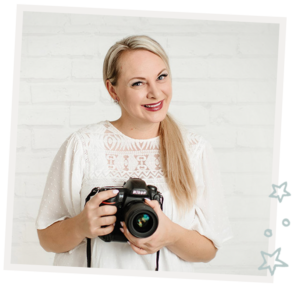
I'm
Lisa DiGeso
I’m on a mission to create uplifting online experiences for photographers ready to elevate their art, their business and their mindset.(...and have fun along the way!)

